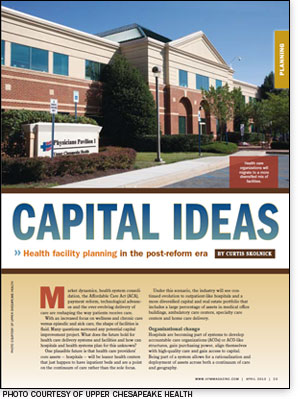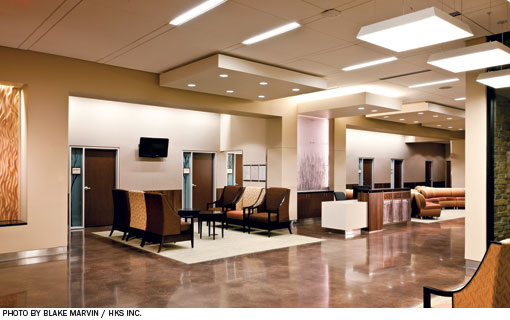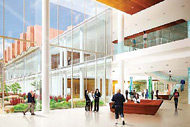 Market dynamics, health system consolidation, the Affordable Care Act (ACA), payment reform, technological advances and the ever-evolving delivery of care are reshaping the way patients receive care.
Market dynamics, health system consolidation, the Affordable Care Act (ACA), payment reform, technological advances and the ever-evolving delivery of care are reshaping the way patients receive care.
With an increased focus on wellness and chronic care versus episodic and sick care, the shape of facilities is fluid. Many questions surround any potential capital improvement project. What does the future hold for health care delivery systems and facilities and how can hospitals and health systems plan for this unknown?
One plausible future is that health care providers' core assets — hospitals — will be leaner health centers that just happen to have inpatient beds and are a point on the continuum of care rather than the sole focus.
Under this scenario, the industry will see continued evolution to outpatient-like hospitals and a more diversified capital and real estate portfolio that includes a large percentage of assets in medical office buildings, ambulatory care centers, specialty care centers and home care delivery.
Organizational change
Hospitals are becoming part of systems to develop accountable care organizations (ACOs) or ACO-like structures, gain purchasing power, align themselves with high-quality care and gain access to capital. Being part of a system allows for a rationalization and deployment of assets across both a continuum of care and geography.
Most systems typically have a flagship facility with several satellites. These satellites used to be smaller versions of the flagship and services were duplicated in a hospital-centric model. However, this model is changing and providers are beginning to rethink the role of the community hospital while taking advantage of system synergies to reduce operating costs and improve quality.
Focusing on the community hospital integrated delivery systems, these organizations are beginning to transform themselves into wellness systems with distributed networks that focus less on episodic care and more on the best way to manage the health of populations.
These systems are readying themselves for a realistic future where fee for service is significantly reduced or goes away, and providers are reimbursed for value and quality, not how many patients pass through an inpatient bed. The incentives will be to keep only those who absolutely need a hospital stay (e.g., trauma patients, those who are critically ill and birthing mothers) in inpatient beds. Providers will be rewarded by demonstrating that they have positively impacted the quality of care.
By more aggressively placing resources in the community (e.g., primary care providers, hoteling specialists and ambulatory diagnostics) to manage chronic conditions, the hope is to avoid high-cost hospital stays and improve population health. Patients suffering from such chronic diseases as diabetes, congestive heart failure, chronic obstructive pulmonary disease and hypertension account for a large portion of hospital stays. If diagnosed early and managed appropriately, overall health can be improved and many costly hospital stays can be avoided.
Therefore, the capital improvements that are made on these campuses will only be made to:
- meet a changing strategic, service or clinical need that has to be provided in an inpatient hospital setting;
- address critical infrastructure issues and upgrades;
- address standard of care issues to ensure high quality of care.
Facility response
While there always will be room for large, complex, regional and academic tertiary care medical centers, the majority of consumers come in touch with community hospitals. Now that more and more are partnered with larger systems, they have the impetus and capital to reinvest and reinvent themselves in a synergistic way with other elements of the system.
These community hospitals are rightsizing and surrounding themselves with ancillary and complementary services, either on- or off-campus. Non-core assets, such as indirect administrative functions, reference labs, information technology and supply chain functions are being consolidated in remote, lower-cost centralized centers to serve multiple system operating units.
Smaller is not necessarily the focus but a byproduct of building only what is needed to manage both first and life cycle costs. This is demonstrated by several recent community hospital projects, including one in the Southeast currently under construction, one in the Southwest that is up and running, and one along the Eastern Seaboard still in the planning and design phases. Master planners are smartly planning facilities to quickly grow horizontally and vertically, should the need arise.
There are many metrics used when evaluating how efficiently a hospital is built from a space perspective, but one metric commonly utilized is building gross square feet (BGSF) per bed. Several years ago, a common target was about 2,500 BGSF per bed for small to midsize community hospitals of about 150 beds such as the three previously mentioned. This took into account an array of hospital services (i.e., emergency departments (EDs), radiology and surgery), an all-private room mix on the inpatient side and full complement of mechanical, support, administrative and ancillary services.
When designed and built, significant shell space was included in anticipation of growth, driving the ratio and cost higher with a theme of one-stop shopping for a community in one high-cost building. However, this is at odds with the new reality of pushing non-inpatient and non-direct care elements out of the hospital and into easier-to-access, lower-cost, high-quality settings.
Now it is not uncommon to see the target of BGSF per bed in the core hospital adjusted to between 2,000 and 2,250 BGSF per bed. So, what do these hospitals include? Some of the elements are:
Redefined public spaces. While still necessary for a variety of reasons (e.g., multipurpose space, wayfinding and initial access), the purpose of lobby spaces has changed to be multifunctional. A common sentiment of hospital administrators is that they are not getting reimbursed to have people waiting, so planners should get patients in and out of the point of care as quickly as possible while still ensuring a high quality of direct patient care. Lobby spaces in smaller community hospitals have evolved from exclusively waiting and respite areas to being meeting places, cafeteria seating extensions, hospital "fair" zones, retail markets and community function spaces. Instead of having many larger, underutilized spaces, these new lobbies can be planned as an efficient use of space, creating a sense of place while being an inviting resource.
Leaner nursing units. Building on a 30-by-30-foot structural grid provides maximum flexibility and makes for large patient rooms and nursing units. Private patient rooms (including toilet rooms) approach 315 square feet. This is not extravagant, but large enough for med-surg patients and potential retrofit later for intensive care unit rooms. Reducing the structural grid to 28-by-28-foot bays allows for a room size of around 260 square feet, which is sufficient for med-surg, but limits future flexibility. There is ample support space available in either model. One metric when looking at nursing unit size is departmental gross square feet (DGSF) per bed. Once planned for 700 DGSF per bed, the three sample facilities previously mentioned came in at around 550 to 650 DGSF per bed and are functionally sound.
Fewer inpatient beds. There has been a continuing shift from one- and two-day lengths of stay to less than one-day observation status and a continuing shift of inpatient care to an outpatient setting. In response, inpatient bed demand has declined and the proportion of patients remaining in hospitals for observation has increased. While requiring much the same support as an inpatient, these observation patients do not require inpatient rooms. Observation patient rooms are 180 square feet. Some include private toilets while others utilize a "shared between two rooms" model. Furthermore, these rooms do not require an outside window, thus eliminating the need for exterior wall access. The result means being able to care for patients in a smaller, more efficient and less costly environment.
Shared diagnostic and treatment platforms. While there are obvious differences in the direct care activities of the surgical suite, radiology, ED and noninvasive diagnostics, advances in workflow redesign and information technology have made these areas more space-efficient. It seems as though the size of operating, treatment and procedure rooms has become larger because of the need for privacy and to accommodate medical and clinical technologies. However, in the sample hospitals, the number of entry and registration points has been reduced greatly. With the exception of ED patients, all other diagnostic and procedure patients enter and check in through one portal of entry and control. Preregistration is encouraged, making the arrival process merely one check-in that can occur at an automated kiosk, thus reducing or eliminating the need for staffed registration booths. Staff can share locker, lounge and indirect support spaces, reducing duplication and encouraging back-of-the-house interactions.
Altered support, ancillary and administrative spaces. Each sample hospital is part of an integrated delivery system. As such, many support, ancillary and administrative services are centrally housed off-site, requiring only a satellite function at the hospital site.
The result is a hospital that includes only core functions to run day-to-day operations and eliminates duplication of effort and costly space, staff and equipment. One example is a centralized distribution center in one system that manages the supply chain for all operating units. Each operating unit receives daily deliveries from the central distribution center and inventory space at the hospital is kept at a minimum. One of the sample hospital systems has a central laboratory and pathology function where most specimens are sent for testing and analysis. Hospital labs are mostly automated routine testing labs with some manual stations and areas for blood banks while the more complex and esoteric tests are batched and processed centrally. Less space and equipment are required at the high-cost core hospital.
Ambulatory space moved out of the hospital. The three sample hospitals have a mixture of additional on- and off-campus assets. Two are part of larger medical wellness campuses being developed partly by a health system and partly by outside developers. All have outpatient and specialty physician office space provided in on- and off-campus space in lower-cost, easier-to-access settings. On-campus, allowing these services to aggregate with the hospital and other complementary services (e.g., pharmacy and medical retail) provides a wellness and health care destination. Off-campus, primary care, specialty care and, in some instances, emergency, surgical and high-end diagnostic and treatment services (e.g., imaging and cancer care) are pushed into the communities closer to the patients being served.

Changing deployment
The focus of health care delivery is changing from episodic care to one of managing the health of populations. In response, the deployment of health facility assets also needs to change.
While there always will be a need for core hospital assets, the successful organizations are shifting their focus to outpatient care, lower-cost and more easily accessible ambulatory settings, and are deploying financial, clinical and caregiver resources to these assets. hfm
Curtis Skolnick is vice president of KLMK Group Inc., Richmond, Va. He can be reached at cskolnick@klmkgroup.com.
| Sidebar - How one hospital is planning for the future of health care |
| One large, well-established multihospital system in the mid-Atlantic is wrestling with its on- and off-campus strategies. Comprising five hospitals, several large ambulatory care centers and a few smaller physician offices, the system's vast majority of capital funds and development activity has occurred on the inpatient-centric hospital campuses.
Each campus varies in age and need with strategic growth, infrastructure and standard-of-care upgrades required. However, there is growing sentiment that the system needs to bolster its position to blanket the communities it serves to truly manage the health of the population and respond to the future of an accountable care organization (ACO) with an integrated health plan, declining fee for service and an increase in incentives to keep patients out of the hospital. In response, the system is developing scenarios to rightsize its inpatient chassis and position the system in the market to capture patients and care for them under an ACO model that includes a large employed primary care and multispecialty physician group, potential health plan and a continuum of care. Actions being taken include:
The transition to population health will challenge the capital-planning priorities of every health care system. This provides an example of how one organization is meeting that challenge. |





